
Entrevista a Deborah Stratman
La artista norteamericana Deborah Stratman (Washington DC, 1967), debutó como directora en 1995 con su película titulada “ON THE VARIOUS NATURE OF THINGS”.
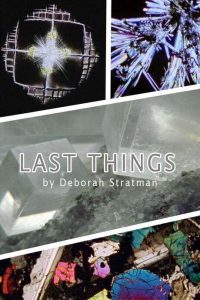 Mi primera aproximación a su cine fue en el festival de cine de Valdivia. Ese año (2017) vi “In order not to be here” (2022), una película que se construía a partir de grabaciones de radio de policía, imágenes nocturnas de la ciudad y la inquietante sensación de que algo siempre estaba a punto de ocurrir. Esto me generó un interés especial en su Cine, por cómo construía atmósferas sonoras y como trabajaba las imágenes cargándolas de un misterio que debía ser develado.
Mi primera aproximación a su cine fue en el festival de cine de Valdivia. Ese año (2017) vi “In order not to be here” (2022), una película que se construía a partir de grabaciones de radio de policía, imágenes nocturnas de la ciudad y la inquietante sensación de que algo siempre estaba a punto de ocurrir. Esto me generó un interés especial en su Cine, por cómo construía atmósferas sonoras y como trabajaba las imágenes cargándolas de un misterio que debía ser develado.
Ahora cursando mi postgrado en Barcelona me encontraba trabajando en el Festival de Cine L’Alternativa y nuevamente me topé con una creación de Stratman, “Last Things”, película que no me decepcionó, al contrario logró que mi interés por la autora norteamericana creciera.
El cine de Stratman es sumamente inmersivo, el espectador debe entregarse casi al trance visual y sonoro que nos presenta. Algo hipnótico que cuando se sale de la sala pareciera que algo en el mundo ha cambiado, o al menos eso es lo que a mí me ocurre.
Estando en dicho Festival, por una feliz coincidencia, a través de Tess Renaudo, una de las Directoras de este evento fílmico, me puse en contacto con Deborah y le pedí, que a través de una entrevista me pudiese explicar un poco sobre su cine, su vida y su manera de ver el mundo.
A continuación, les dejo el resultado de esta conversación que tuvimos por escrito este mes de enero entre Barcelona y Chicago.
Me gustaría comenzar preguntándote sobre tu formación como artista. ¿Qué tanto ha cambiado tu visión desde que comenzaste a hacer arte hasta ahora?
Si te refieres a mi “visión” en términos de plan o intención con respecto a trabajo futuro, no ha cambiado mucho. Siempre he trabajado porque no lo sé, entonces voy a tientas, encontrando un camino. Nunca he tenido un sentido de propósito visionario, o de qué debería hacer. Sólo me intereso en algún fenómeno, o paisaje, o idea, o persona, o situación y luego me pierdo en la investigación, o la conversación o en la excavación. Supongo que hay un mayor sentido de urgencia ahora en tener las cosas hechas, soy más consciente de mi entropía. Intento no desperdiciar la plataforma que se me ha dado.
Si te refieres a mi visión en el sentido literal, se ha ido a la mierda. Necesito gafas desde que soy adolescente, pero ahora tengo una terrible visión nocturna, y todo tipo de desechos en el humor vitro de mis ojos que hacen difícil leer o cualquier cosa con poca luz. Desde que soy pequeña, mis ojos han tenido distinto balance de color. Si veo una hoja de papel blanca, mi ojo derecho la ve levemente más cálida y mi ojo izquierdo la ve levemente más fría. Me pregunto si esto significa que veo las cosas con un poco más de dimensión.
¿Cuál crees que es la mejor manera de definir tu arte?
El arte es mi interfaz con el mundo. Es como inventar un lenguaje, uno que me ayuda a articular preguntas que tengo para este lugar. Otras veces está más cerca a un acto de traducción o de citación. Cuando enciendo la cámara es como citar, excepto que es una citación que cambia el tejido de las cosas. Kirsten Johnson dice que encender la cámara significa que estás dejando entrar el futuro en la habitación.
¿Cómo comenzaste a hacer películas? ¿Hay influencias que crees que hayan sido importantes en este proceso?
Comencé haciendo películas con la cámara Super-8 de mi padre. Pero no fue hasta algunos años después que cambié de carril desde la ciencia al arte. El video 3/4” ya estaba cuando era estudiante, pero yo estaba más atraída a la naturaleza mecánica de la cámara con celuloide. Disfruté aprender sobre lentes y comencé a prestarle atención a la luz. También me gustó construir y liberar presión a través de la edición – esculpir volúmenes temporales. Creo que lo que me mantuvo interesada en el medio fue la oportunidad de manipular y crear espacios con el sonido.
Muchas influencias. Mis padres, especialmente mi madre con su compromiso con la justicia social. Ella introdujo a mis hermanos y a mi en comunidades diferentes a la nuestra. Mi padre es un modelo de masculinidad amable y clandestinamente graciosa. Son personas muy apasionadas y muy comprometidas, capaces de escuchar y respetar las diferencias.
Cuando tenía al rededor de veinte años, tomé un curso con Peter Kubelka en edición y pasó que me di cuenta de que el cine podía ser una forma de arte insurgente—mucho más variable que el cine al que había estado expuesta hasta ese entonces. Fui proyeccionista de 35mm durante muchos años. Creo que eso fue me mas grande maestro porque tuve que ver muchas películas.
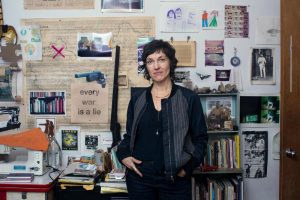
Me gustaría saber sobre tu proceso. Existen algunas preguntas o temas que pueden ser identificados en, como el paso del tiempo o la sociedad americana, pero ¿cómo te aproximas a la manera de filmar estos temas?
Mi acercamiento es diferente para cada película. Algunos comienzan con un largo periodo de investigación y recolección. Algunas películas las hago en un día. Algunas son en respuesta inmediata o una comisión. Otras comienzan con una pregunta más filosófica y durante el proceso de filmación comienzo a mejorar en articular la pregunta. Algunas películas comienzan con un concepto muy claro o algún tipo de coreografía que ya he trabajado, y la preproducción es mayormente sobre encontrar la locación precisa para filmarla. Una película como Hacked Circuit fue estructurada de esa manera, o Inmortal, Suspended que fue una suerte de carrera de práctica para Hacked Circuit, para ver cómo se logra el significado en películas sin cortes.
Lo importante es encontrar una forma que se sienta endémica para la película que está naciendo. Intento servirle a la película sobre todas las cosas. Algunas películas elijo grabarlas en vídeo por la portabilidad, la velocidad, el costo, etc. En otras elijo el celuloide porque el paso más lento de trabajo encaja mejor con mi proceso de ideas. En su raíz, trabajar con film (celuloide) es alquimia, y es una especie de grabado en piedra, donde la luz talla los minerales de la emulsión. El grano respira y hormiguea de una manera que el video es incapaz. También, a veces tomo el medio que esté disponible. Grandes películas pueden ser hechas en cualquier formato.
Lo principal que puedo decir sobre el proceso es que mis películas son hechas en edición. Aunque extiendo “edición” para incluir la manera de encuadrar una imagen, porque estoy editando la mayor parte del mundo con cada plano. Soy de pensamiento asociativo, una collagista. Amo experimentar con la colocación de bloques de tiempo heterogéneo uno al lado de otro.
En la película “In order not to be here” creo que está el ejemplo perfecto sobre la construcción de una atmósfera usando el sonido, como si algo estuviese siempre a punto de pasar. Podrías hablar sobre la manera en la que usas y trabajas con el sonido en tus películas y cómo creas estas atmósferas y sensaciones?
El sonido es subversivo. A diferencia del encuadre, no tiene un marco y puede evocar una infinita variedad de escalas y espacios , desde algo extremadamente íntimo, incluso desde adentro del cuerpo, hasta algo vasto. El sonido es el contenedor en donde todo lo de más existe dentro. Puede hacerte consciente de los límites de las cosas. Puede construir suspenso, puede sobrecoger con sorpresa, puede calmar, puede agitar. Es totalmente psicológico. Es dificil para mi hablar del sonido porque es una parte enorme de mi cine, mas de la mitad de cada película que hago. Estoy pensando en el sonido desde el inicio. A veces antes del inicio. Es fantástico que haya mucho trabajo que puedo hacer con la banda de sonido que sería exorbitantemente caro, o logísticamente una pesadilla de intentar y hacer de manera visual. Uso el sonido como un solucionado de problemas y como un constructor de mundos.
El sonido de In Order Not To Be Here se apoya de fuerte manera en la música de Kevin Drumm. Estaba en Nueva York en una tienda de discos y compré su disco “Comedy”. Lo encontré brillante y lo localicé para ver si le interesaba una colaboración. Fue recién ahí cuando me di cuenta de que vivía en Chicago (como yo). Las composiciones de Drumm para la película son una mezcla de canciones que ya existían y nuevo audio que él hizo para mí después de hablar y mirar algo de mi material filmado. El resto del audio es de grabaciones de campo que hice y audio que recolecté de reportes de policía.
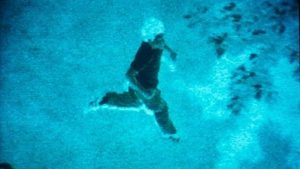
Recientemente viendo “O’er the Land”, me recordó mucho a los documentales de Frederick Wiseman, principalmente “Law and Order” y “High School”, por la idea de construir una sociedad a partir de instituciones que están por toda la ciudad. Me gustaría saber cuál era la idea principal cuando comenzaste a trabajar en esta película y si fue cambiando a lo largo del proceso.
Interesante. No estaba pensando en Wiseman, aunque me gustan sus películas. Diría que mi trabajo en general tiene un interés en la infraestructura: electricidad, telecomunicaciones, desechos, agua, planificación urbana, todas las maneras en las que estamos regidos o controlados por la arquitectura.
O’er the Land comenzó a partir de la idea sobre qué perdemos en nombre de la “libertad” y sobre lo icónico y mítico de las representaciones americanas de la libertad. Pareciera que definimos libertad en términos de pertenencias. Y defendemos la idea de que libertad significa defender lo tuyo, tu propiedad, tu tierra, tus fronteras. Si definimos libertad a través de las pertenencias entonces estaremos encerrados en una creciente espiral de gasto en defensa. Creo que es una profunda perversión eso que la libertad tiene el potencial de ser una liberación de las posesiones, elegir renunciar al control, ser testigo o rendirse a algo enorme que no somos nosotros.
La historia que ocurre en medio de la película del Coronel William Rankin teniendo que expulsarse de su jet de combate a 48.000 pies de altura, pasado la atmósfera respirable, que sobrevive solo para entrar en una tormenta masiva en la que queda atrapado por cuarenta y cinco minutos… esta historia fue algo con lo que me crucé buscando las razones de por qué falla la red eléctrica. Tenía esta historia antes de que la película fuese ni siquiera una idea en mi cabeza. Si hay algo de lo que como sujetos no podemos liberarnos es de la gravedad. Aún así aquí hay un hombre que cuyo cuerpo evadió la gravedad por cuarenta y cinco minutos. No podía caer, como lo hacen siempre los cuerpos. Me di cuenta de que esta historia podía ser una muy buena linea central para los otros episodios y ponerlos en relación entre sí. Es implacablemente físico y duradero, pero al mismo tiempo la historia es alegórica y metafísica.
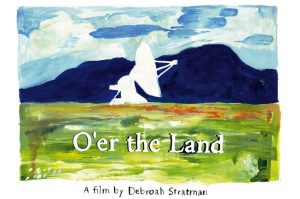
En tu más reciente película “Last Things” hablas sobre el paso del tiempo de una manera bastante especial, porque es una mezcla entre poesía y ciencia. Cómo comenzó esta idea, fue desde las novelas en la que está basada o desde el pensamiento de cómo concebimos el tiempo? Si puedieses explicarnos como fue desarrollada esta película.
Last Things comenzó con las novelas Les Xipéhuz y La mort de la Terre de J.H. Rosny. Inicialmente pensé en hacer una adaptación, directamente más ciencia ficción. Y las primeras cosas que filmé fueron con eso en mente, de lo que llamo “Gente Estrella”. Pero luego en una visita al museo de historia natural en Vienna vi una exhibición de la teoría de evolución mineral de Robert Hazen y esto logró abrir la película para mí. Decidí trabajar con dos tipos de voces: una oracular, conjurada, de ciencia ficción, y otra más plana, descriptiva, de ciencia factual. Una vez tuve esta idea, y encontré a las mujeres que serían mis narradoras, fue mayormente cosa de editar la gran cantidad de lecturas e investigaciones de archivo que había hecho para convertirla en algo denso y eficiente. Quería expresar lo máximo posible con la menor cantidad de movimientos. Como decía Bresson, no uses dos violines su uno es suficiente.
Leo y escarbo y tamizo y creo grandes cantidades de material. Transcribo a tarjetas las ideas que me parecen convincentes. Algunas tarjetas son dibujos, otras son frases. Luego las pongo en una tabla y las revuelvo para pensar en diferentes químicas de combinaciones. No trabajo desde un guión en la manera convencional. Pero mi sistema de tarjetas es un tipo de guión viviente. Claro que algunas que parecen geniales en la tabla resultan siendo terribles cuando las edito. Pero es bueno tener una manera rápida y táctil de revolver conceptos.
Para terminar, tienes algún consejo para jóvenes directores y directoras?
Preguntarse sobre lo habitual, lo cotidiano. ¿Por qué la acera tiene esa altura? ¿Por qué los ladrillos son de ese tamaño? ¿Por qué tomo esta ruta al trabajo? Estas cosas que George Perec llama lo “infra-cotidiano” revelan muchas cosas sobre nuestros tiempos y sobre nosotros.
Diría también que en vez de tratar de mejorar en capturar cosas, mejorar en reconocer qué te captura a ti o te dejan capturarte. ¿Cuándo te abduce el momento? ¿Por qué roba tu atención? Si comienzas a aprender qué te seduce, qué te obliga, qué te mueve, entonces serás un mejor compañero de baile con la vida.
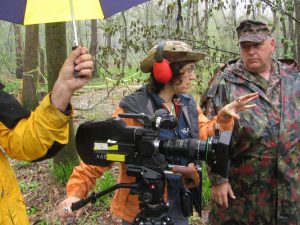
Transcribo ahora la entrevista original en inglés
I would like to start asking you about your formation as an artist. How much has your vision changed since you started doing art until now?
If you mean ‘vision’ it in terms of my plan or intention towards future work… it hasn’t changed too much. I’ve always made work because I don’t know, so I grope around, finding a way. I’ve never had a ‘visionary’ sense of purpose, or what I should make. I just get interested by some phenomenon, or landscape, or idea, or person, or situation, and then I get lost in the research, or the conversation or the dig. I suppose there’s a greater sense of urgency now to get things done, I’m more conscious of my entropy. I try not to waste the platform I’ve been given.
If you mean my literal vision, it’s gone to shit. I’ve needed glasses since my teens, but now I have terrible night vision, and all sorts of debris in the vitreous humor of my eyeballs that makes reading and anything in low light difficult. Since I was little, my eyes have had different color balance. If I’m looking at a white sheet of paper, my right eye sees it as slightly warm and my left eye sees it as slightly cool. I wonder if this means I see things slightly more dimensionally.
What do you think is the best way to define your art?
Art is my interface with the world. It’s like inventing a language, one that helps me articulate the questions I have for this place. Other times it’s closer to an act of translation or quotation. When I turn my camera on, it’s like quoting, except it’s a sort of quotation that changes the fabric of things. Kirsten Johnson says that turning the camera on means you are letting the future into the room.
How did you start making films? Are there any influences that you think that were important for you in this process?
I started making films with my dad’s Super-8 camera in high school. But wasn’t until some years later that I shifted track from science to art. 3/4” video was around when I was a student, but I was more attracted to the mechanical nature of the celluloid camera. I enjoyed learning about lenses and started paying attention to light. I enjoyed building and relieving pressure through editing – sculpting temporal volumes. I think what really kept me interested in the medium though was the opportunity to manipulate and create space with sound.
So many influences. My parents, especially my mother’s commitment to social justice. She introduced my brothers and I to communities unlike our own. My dad modeled a masculinity that was gentle and clandestinely funny. They’re very passionate and committed people, able to hear and respect difference.
When I was about twenty, I happened to take a course by Peter Kubelka on editing which was the first time I realized film could be an insurgent art form—much more variable than the cinema I’d been exposed to up until then. I was a 35mm changeover projectionist for many years. That might have been my greatest film teacher because I got to see so many films.
I would like to know about your process. There are some questions or themes that can be identified in your films, like the pass of the time or the American society, but how do you approach to the way of filming them?
My approach is different for each film. Some films start with a long period of research and collecting. Some films I make in a day. Some are in response to a prompt, or a commission. Some start with more of a philosophical question and through the process of making the film, I get better at articulating the question. Some films start with a clear concept or a sort of choreography that I’ve already worked out, and the pre-production is largely about finding the right location to shoot in. A film liked Hacked Circuit was structured that way, or Immortal, Suspended which was kind of practice run for Hacked Circuit – to see how meaning gets made in a film without cuts.
The important thing is to find a form that feels endemic to the film being born. I try to serve the film above everything else. Some films I choose to shoot on video for portability, speed, cost, etc. Other films I choose celluloid because the slower pace of working is better suited my processing of the ideas. At root, working with film is alchemy, and it’s a sort of stone-carving, where light carves the minerals embedded in the emulsion. The grain breathes and swarms in a way video is incapable of. Also, I sometimes just choose the medium that’s available. Great films can be made on any format.
The main thing I can say about process is that my films are made in the editing. Though I extend ‘editing’ to include the way I frame an image, because I’m editing out most of the world with every shot. I’m an associative thinker, a collagist. I love experimenting with placing blocks of heterogenous time beside one another.
Recently watching “O’er the Land” it reminds me a lot of two documentaries by Frederick Wiseman, “Law and Order” and “High School,” for the idea of building a society about institutions that are all over the city. I would like to know what was the main idea when you started to work on this film and if it changed while you were doing it.
Interesting. I wasn’t thinking of Wiseman, though I do like his films. I’d say my work in general has an interest in infrastructure: electricity, telecommunication, waste, water, urban planning, all the ways we are policed or controlled by architecture.
O’er the Land started from thinking about what we lose in the name of “freedom” and about iconic or mythic American representations of freedom. We seem to define freedom in terms of ownership. And to defend freedom means defending what you own, your property, your land, your borders. If we define freedom through ownership then we’ll always be locked into increasing spirals of defense spending. I think it’s a deep perversion of what freedom has the potential to be—an untethering from possessions, choosing to relinquish control, a witness to or surrendering to something enormous that is not us.
The story that occurs in the middle of the film of Colonel Willam Rankin having to eject from his fighter jet at 48,000 feet, way above breathable atmosphere, who survives only to drop into a massive thunderstorm into which he is tossed around for 45 minutes…. this story was something I came across while researching reasons why the electric grid fails. I had this story before the film was even an idea in my mind. If there’s one thing we’re all subject to and cannot be free of, it’s gravity. And yet here’s a man whose body evaded gravity for 45 minutes. He could not fall, as bodies always do. I realized this story could be a very good central vertical beam for all of the other film episodes to dispose themselves in relation to. It’s unrelentingly physical and endured, but at the same time the story is allegorical, metaphysical.
In your film “In Order Not To Be Here” I think there is the perfect example of the construction of an atmosphere using the sound, like there is always something about to happen. Can you talk about the way you use and work with the sound in your films and how do you create this atmospheres and sensations?
Sound is subversive. Unlike the film frame, it has no edges and can evoke an infinite variety of scales and spaces – from something extremely intimate, even inside the body, to something vast. Sound is the container everything else exists inside. It can make you conscious of the edges of things. It can build suspense, it can startle with surprise, it can soothe, it can agitate. It’s utterly physiological. It’s difficult for me to speak about sound because it’s such a huge part of my cinema, more than half of every film I make. I am thinking about sound right from the beginning. Sometimes before the beginning. I love that there is so much work I can do with the soundtrack that would be outrageously expensive, or logistically nightmarish to try and do visually. I use sound to problem-solve and I use it to world-build.
The sound of In Order Not To Be Here leans heavily on the music of Kevin Drumm. I was in a record store in NYC and happened to buy his disc Comedy. I thought was brilliant and I reached out and see if he might want to collaborate. It was only then that I learned he lived in Chicago (like me). Drumm’s compositions for the film are a mix of songs that already existed and new audio he made for me after talking and looking at some of my footage. The rest of the audio is from field recordings I made and audio I collected from police reports.
In your more recent film “Last Things” you talk about the pass of the time in a very special way, because it is like a mix between poetry and science. How did that idea start, was it from the novels that is based on or from the thinking of the time and the way that is conceived by us? If you could explain to us how you developed this film.
Last Things began with the J.H. Rosny novellas Les Xipéhuz and La Mort de la Terre. I initially thought I would make an adaptation, more of a straight up science fiction. And the earliest things I shot were with that in mind, of what I call the Star People. But then on a visit to the Natural History Museum in Vienna I saw an exhibit about Robert Hazen’s theory of mineral evolution and this broke the film open for me. I decided to work with two sorts of voices – an oracular, conjuring, science-fictional voice, and flatter, descriptive, science-factual voice. Once I had this idea, and found the women who would be my narrators, it was largely a matter of editing down the huge amount of reading and archival research I’d done into something dense and efficient. I wanted to express as much as I could in the least number of moves. Like Bresson says, don’t use two violins if one is enough.
I read and dig and sift and create great stacks of material. I transcribe to index cards the ideas I find most compelling. Some cards are drawings, some are phrases. Then I pin those up on a board and shuffle them around to think about different combinatory chemistries. I don’t work from a script in the conventional sense. But my index card system is a sort of living script. Of course something that seems great on the bulletin board might be terrible when I actually try it in the edit. But it’s nice to have a quick, tactile way to shuffle concepts around.
To finish, do you have any advice for the young directors and filmmakers?
Question the habitual, the quotidian. Why is the curb that height? The brick that size? Why do I take this route to work? These things that George Perec calls the ‘infra-ordinary’ reveal many things about our times and ourselves.
I’d also say instead of trying to get better at capturing things, get better at recognizing what captures you, or at letting yourself be captured. When does the moment abduct you? Why did it steal your attention? If you start to learn what seduces you, what compels you, what moves you, then you’ll be a better dance partner with life.